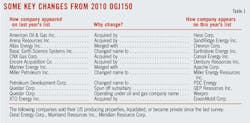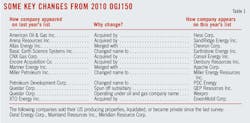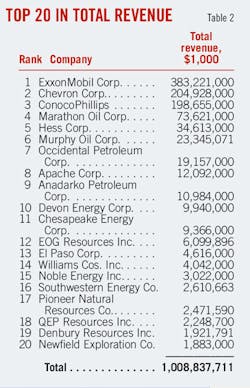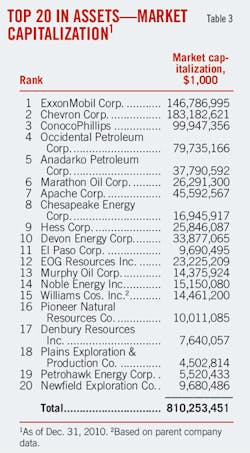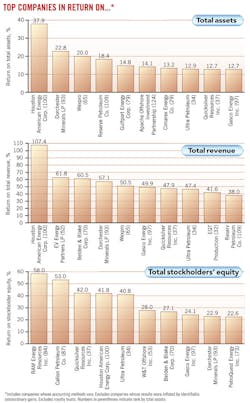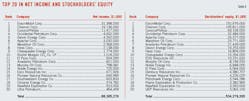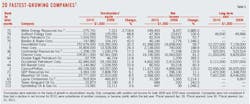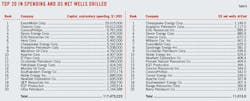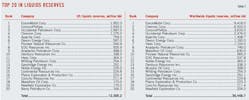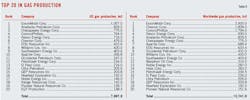Marilyn Radler
Senior Editor-Economics
Laura Bell
Statistics Editor
The OGJ150 group of oil and gas producers recorded much-improved 2010 financial and operating results compared with results from a year earlier, buoyed by stronger crude prices and increased production volumes.
A rebound in global economic growth last year provided a boost to worldwide oil demand, which climbed to average 88.2 million b/d, up from 85.5 million b/d in 2009, according to the International Energy Agency. Most of the 2010 oil demand growth was recorded in developing countries, as Organization for Economic Cooperation and Development (OECD) members posted a combined 600,000 b/d increase in oil demand.
Oil prices climbed as demand growth outpaced supply growth. Total output from members of the Organization of Petroleum Exporting Countries last year increased to 34.8 million b/d from 34.1 million b/d a year earlier, IEA estimates show, while non-OPEC oil supply increased by 1 million b/d to reach a 2010 average of 52.6 million b/d.
The average near-month futures price in 2010 of West Texas Intermediate and for Brent crude oil was about $80/bbl, up from the year-earlier average of $62/bbl for both. At the same time, average natural gas prices were little changed year-on-year.
At 137, the number of companies that qualified for this year's OGJ150 is unchanged from a year ago, as the count of firms joining the group is about the same as those that are no longer listed due to mergers and acquisitions (OGJ, Sept. 6, 2010, p. 50).
To qualify for the OGJ150, oil and gas producers must have their headquarters in the US, be publicly traded, and hold oil or gas reserves in the US. Companies appear on the list ranked by total assets but also are ranked by revenues, stockholders' equity, capital expenditures, earnings, production, reserves, and US net wells drilled.
The 137 firms in the group posted combined 2010 earnings of $90.8 billion, up sharply from their combined 2009 net income of $25 billion. The group's combined 2010 revenues climbed by 25% to $1 trillion.
Changes since a year ago
While there are 11 companies that are new to the group, a dozen others that were included last year no longer appear in the compilation. Most of these were acquired by or merged with others that are included, such as XTO Energy Inc., which was acquired by ExxonMobil Corp.
Others that were in last year's OGJ150 merged with private companies, such as Meridian Resource Corp., while Mainland Resources Inc. sold its oil and gas assets. Petroleum Development Corp. changed its name to PDC Energy, and Basic Earth Science Systems Inc. is now called Earthstone Energy Inc.
Questar Corp., which last year was No. 17 in the group, not only is operating under the name Wexpro now but also has spun off a subsidiary named QEP Resources Inc. Both Wexpro and QEP Resources are listed in the current group at No. 65 and No. 21, respectively.
Collective oil, gas results
In 2010 the OGJ150 companies recorded higher combined US and worldwide oil and gas production volumes and reserves from a year earlier. In addition, the group's total US net wells drilled climbed 40% from 2009 to 15,538.1.
Drilling and production activity was especially strong in the US during 2010, propelled by a boom in unconventional oil and gas plays.
The OGJ150 group reported a combined 14% annual increase in US liquids reserves to 14.6 billion bbl and a 19% climb in US gas reserves to 149.3 tcf. On a worldwide basis, the group booked more modest reserves increases of nearly 4% for liquids to 32.9 billion bbl and 11% for gas to 222.6 tcf.
The combined US gas production of the OGJ150 group climbed by almost 7% from 2009 to reach a total of 10.37 tcf. Worldwide, these companies produced 16.38 tcf, a 5% increase from a year earlier.
The group's combined US liquids production was 1.08 billion bbl vs. 1.04 billion bbl a year earlier, while their collective worldwide production of crude, condensate, and NGL totaled 2.84 billion bbl, up from 2.76 billion bbl.
Financial results
While the combined financial results of the OGJ150 group were improved from 2009, some companies recorded declines and losses. There are 43 companies in the group that posted a net loss for 2010, but 41 others reported annual earnings exceeding $100 million.
The company with the highest 2010 revenues is ExxonMobil, which reported 383.2 billion in revenue, up from $310.6 billion a year earlier.
The highest-ranking company to report a net loss for 2010 is No. 15 Williams Cos. Inc. The Tulsa-based company posted $4 billion in revenues for the year, and attributes its $1.36 billion loss to noncash impairment charges and restructuring costs.
Williams reported that the noncash impairment charges in its exploration and production segment during last year's third quarter were due to a decline in forward natural gas prices. These included pretax charges of $1 billion for an impairment of goodwill and $678 million related to certain proved and unproved natural gas properties, primarily in the Barnett shale.
First-quarter pretax costs of $648 million in conjunction with the strategic restructuring that transformed Williams Partners LP into a master limited partnership also contributed to the net loss for 2010, Williams reported.
Companies with refining operations benefitted from slightly improved cash refining margins in most areas of the US during 2010 vs. 2009. Cash margins were higher for US East Coast, Gulf Coast, and Midwest refiners on average, according to figures from Muse, Stancil & Co. (MSC).
Still, US East Coast margins were anemic, averaging $1.82/bbl last year vs. their 2009 average of $1.12/bbl. Meanwhile, US West Coast margins averaged $9.33/bbl last year, down from their 2009 average of $10.30/bbl, according to MSC.
Input costs moved higher last year, as the composite refiners' acquisition cost of crude averaged $76.70/bbl in the US, up from $59.20/bbl a year earlier, according to the US Energy Information Administration.
US gasoline prices also were higher in 2010, with self-service unleaded motor gasoline excluding tax averaging $2.23/gal, up 24% from a year earlier. Including tax, the average pump price climbed 19% to $2.77/gal last year.
Fast growers
No. 72 Miller Energy Resources, formerly Miller Petroleum Inc., is the fastest-growing company of the OGJ150. With headquarters in Huntsville, Tenn., Miller Energy Resources boosted its stockholders' equity during 2010 to $275 million from $7 million, while the company's earnings jumped to $249 million from $8 million a year earlier.
During 2010, Miller Energy Resources expanded its operations through the acquisition of oil and gas assets from Pacific Energy Resources through a bankruptcy proceeding, including various onshore and offshore production and processing facilities. The company also acquired assets in Alaska's Cook Inlet and additional assets in the Appalachian region last year through the acquisition of Ky-Tenn Oil Inc. and East Tennessee Consultants Inc.
The list of the fastest-growing companies ranks the firms by their growth in stockholders' equity. To qualify for this list, a company in the OGJ150 must have recorded positive net income for both 2010 and 2009 and must have posted an increase in net income last year. Excluded from this list of fast growers are limited partnerships, newly formed public companies, and subsidiaries.
Normally a list of the top 20 fastest-growing companies in the OGJ150, only 17 of the firms qualified this year. In the previous edition of this special report, none qualified.
No. 79 Gulfport Energy Corp. is the second fastest-growing company in the group, having grown its stockholders' equity by 69% while doubling its 2010 earnings from a year earlier to $47 million.
The rest of the top five fastest-growing firms in the group are No. 41 Berry Petroleum Co., No. 70 Belden & Blake Corp., and No. 1 ExxonMobil.
Top 20 companies
The top 20 companies in the OGJ150 as ranked by yearend 2010 assets are so large that they hold 89% of the assets of the entire group. They also account for 92% of the entire OGJ150 group's 2010 worldwide liquids production but only 60% of the group's US net wells drilled during the year.
This group of 20 contains two companies that were not included in the top 20 of the previous edition of the OGJ150. With XTO Energy having been acquired by ExxonMobil and what was Questar now operating as two entities, Denbury Resources Inc. and Newfield Exploration Co. have joined the top 20 group of companies as ranked by total assets.
Denbury, based in Plano, Tex., is ranked No. 17, up from No. 24 a year ago, and reported yearend 2010 assets of $9 billion. With total assets of $7.5 billion, Houston-based Newfield Exploration is now No. 20, up from last year's No. 21.
ExxonMobil again tops the OGJ150 group with assets of $302.5 billion. At the end of 2009, the company's assets totaled $233.3 billion. Earnings jumped to $31.4 billion in 2010 from $19.7 billion a year earlier.
Following ExxonMobil are Chevron Corp. and ConocoPhillips, unchanged in rank from a year ago, and then Occidental Petroleum Corp., which was last year's No. 6 company.
Apache Corp. a year ago was ranked No. 11, with $28.2 billion in assets but now is No. 7, as the Houston-based independent's assets at the end of 2010 totaled $43.4 billion. During 2010 Apache reported $11 billion in acquisitions.
Earnings leaders
As they did a year ago, ExxonMobil, Chevron, ConocoPhillips, and Oxy top the list of net income leaders.
Twelve of the companies in this list of top earners for 2010 recorded a net loss in 2009, including Devon Energy Corp., Apache, and Chesapeake Energy Corp.
Chevron reported an 81% increase in earnings from 2009 to $19 billion. Upstream and downstream results improved on higher oil prices, higher net oil-equivalent production, and improved sales margins for products from refining, the company said.
Meanwhile, ConocoPhillips's earnings jumped to $11.4 billion from $4.9 billion, and Hess Corp. reported that its 2010 earnings were 2.1 billion, up from $740 million a year earlier.
Ranked No. 38 by assets, Exco Resources Inc. is the fifteenth highest in 2010 net income, posting a $671.9 million profit that resulted from a large gain on divestitures and derivatives. The company's 2010 revenue was $515.2 million.
Spending, drilling leaders
The 20 companies in the OGJ150 group that had the largest capital and exploratory spending in 2010 combined for a total of $117.5 billion in such outlays. Most of these companies boosted capital spending from 2009.
ExxonMobil led the group by a wide margin with worldwide spending of $29 billion, up 18% from 2009 outlays, followed by Chevron, whose 2010 spending was $19.6 billion, down slightly from a year earlier.
ConocoPhillips is third with capital spending of $9.8 billion in 2010, down 10% from a year earlier, followed by Devon Energy with $6.5 billion in capital outlays. Devon Energy reported 2009 capital spending of $4.9 billion.
Chesapeake Energy is seventh in terms of 2010 capital spending but first in the count of US net wells drilled for the year. The company reported that its 2010 net wells drilled in the US totaled 1,149.
The four companies heading the list of the top twenty in US net wells drilled are independent producers. With 1,117 net wells drilled in the US last year, Anadarko Petroleum is second on the list, followed by EOG Resources Inc. and Devon Energy.
Chevron, which was sixth a year ago, is now fifth with 672 US net wells drilled in 2010.
Top 20 in oil reserves, production
ExxonMobil tops the OGJ150 companies in reserves of crude, condensate, and NGL both in the US and worldwide. In the US, the company's liquids reserves total 1,952 million bbl, followed closely by ConocoPhillips's 1,934 million bbl. In the previous edition of the OGJ150, ConocoPhillips held the largest liquids reserves in the US.
Worldwide, ExxonMobil's liquids reserves are 9,418 million bbl. Chevron's worldwide liquids reserves are the second-highest, totaling 6,503 million bbl.
With 178 million bbl of output, Chevron produced the most liquids in the US during 2010, followed by ConocoPhillips and ExxonMobil. Worldwide, meanwhile, ExxonMobil produced the most liquids, followed by Chevron and ConocoPhillips. These rankings are unchanged from a year ago.
Sandridge Energy Inc. has moved onto the top 20 lists for liquids reserves following its 2010 acquisition of Arena Resources Inc. Sandridge is No. 13 in terms of its liquids reserves in the US, which total 252.1 million bbl.
Ranked No. 25 by total assets, Concho Resources Inc. is new to the top 20 worldwide liquids reserves list with 211.4 million bbl, up from 142 million bbl a year ago when the company was No. 33 by assets. This Midland-based company reported that 98% of its total estimated net proved reserves as of Dec. 31, 2010, were in the Permian basin and consisted of about 66% oil.
In October 2010, Concho Resources acquired the oil and gas assets of Marbob Energy Corp., a privately held independent with concentrated operations in the Permian basin of Southeast New Mexico.
Gas production, reserves leaders
With its acquisition of XTO Energy, ExxonMobil now tops each list of the leaders in US and worldwide gas production and reserves.
A year ago the leading company in US gas reserves was Chesapeake Energy, followed by XTO Energy and then ExxonMobil. Also a year ago, the company with the most US gas production was XTO Energy, followed by ConocoPhillips, Chesapeake Energy, Anadarko Petroleum Co., Devon Energy, and then ExxonMobil.
No. 23 Consol Energy Inc., new to the OGJ150 this year, is the eleventh company among US gas reserves leaders, having acquired CNX Gas Corp. and the E&P business of Dominion Resources Inc. Consol reported yearend 2010 gas reserves of 3.7 tcf, all located in the US.
Houston-based Cabot Oil & Gas Corp. also joined the top 20 companies in US gas reserves with 2.6 tcf at the end of 2010, up from 2 tcf a year earlier due to success in US shale gas plays, including the Marcellus and Haynesville shales.
Click here to download the pdf of the OGJ150 Companies Report
More Oil & Gas Journal Current Issue Articles
More Oil & Gas Journal Archives Issue Articles
View Oil and Gas Articles on PennEnergy.com
